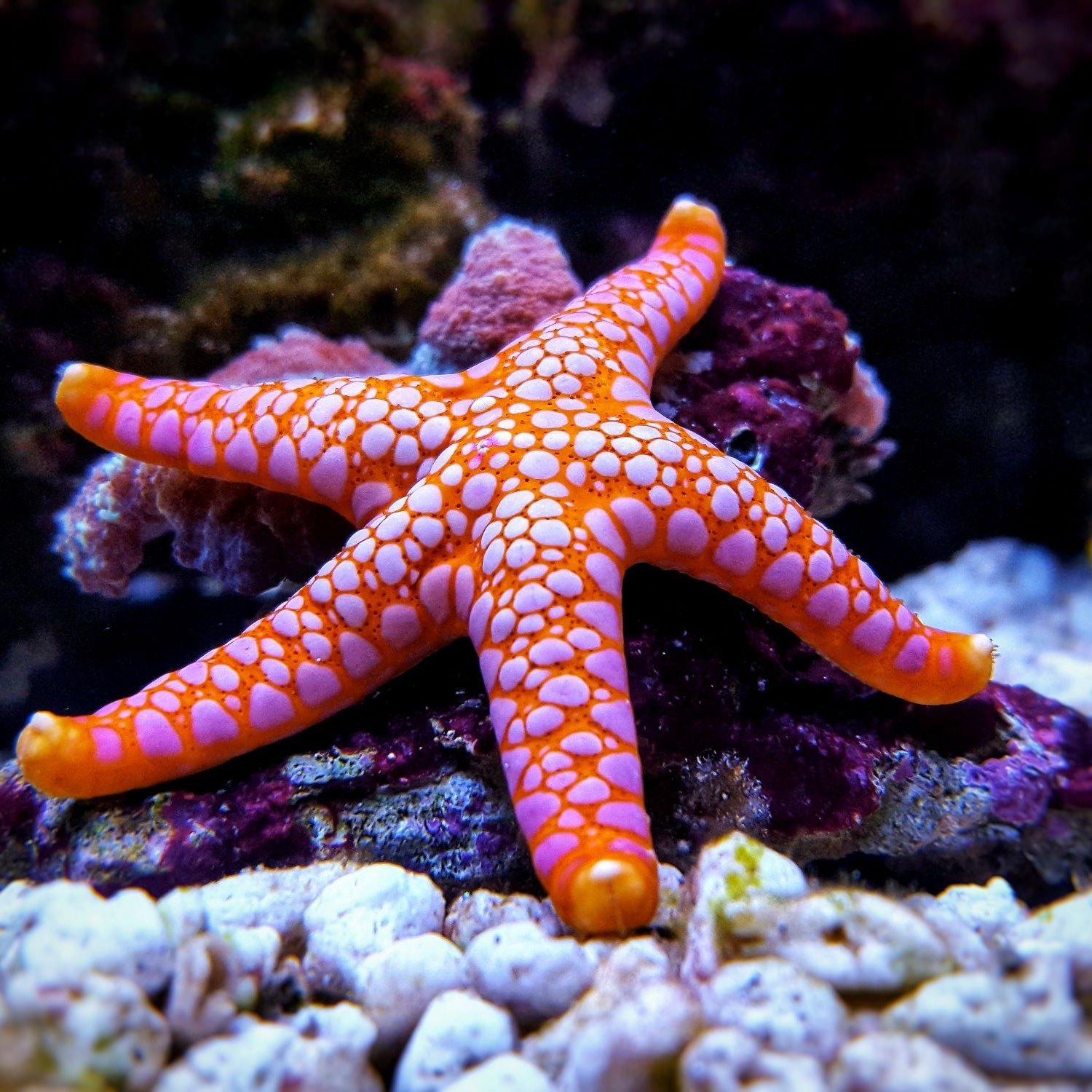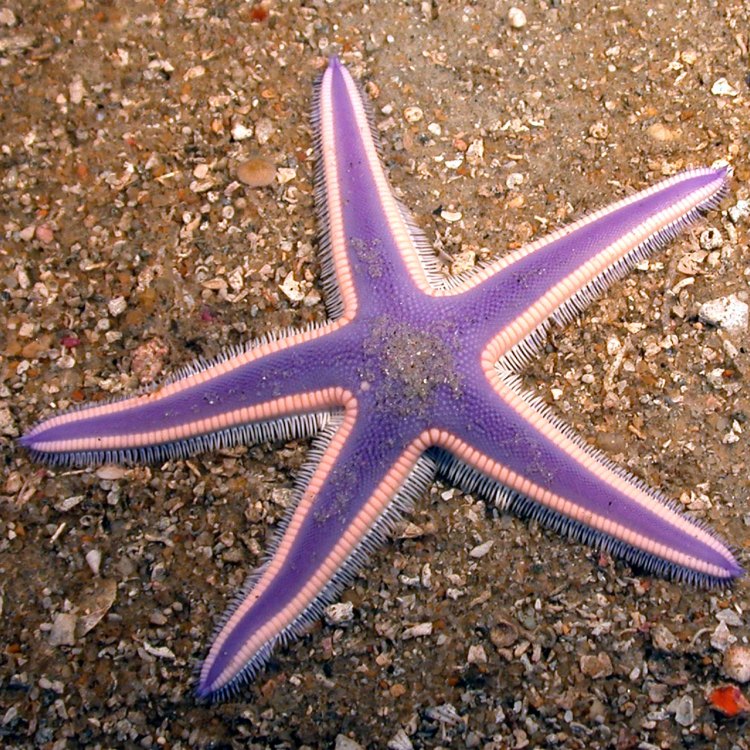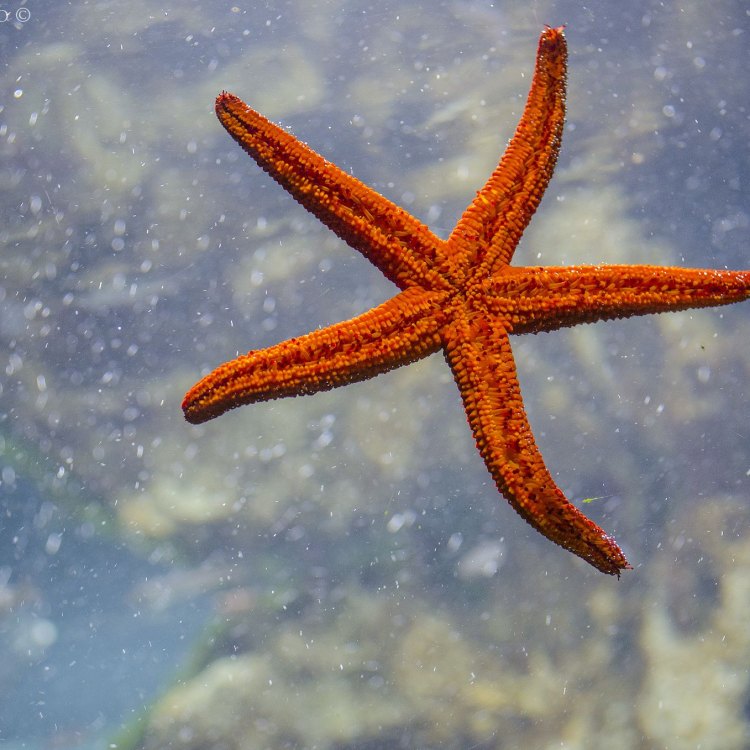
Starfish
0.4-2.5 feet
Did you know that starfish belong to the family Asteriidae and can be found in oceans and seas worldwide? These fascinating creatures have a unique body shape, with 5 to 10 arms radiating from a central disc. Their size can range from 0.4 to 2.5 feet, making them perfect for curious beachgoers to spot and learn about during their seaside adventures. #Starfish #Asteriidae #OceanCreatures
Animal Details Summary:
Common Name: Starfish
Kingdom: Animalia
Habitat: Marine
The Amazing World of Starfish: A Marvel of the Sea
Have you ever spent a day at the beach and come across a colorful and intriguing creature washed up on the shore? Chances are, it was a starfish. These fascinating animals have captured the curiosity of many with their unique appearance and behavior. But there is more to these creatures than meets the eye. Let's dive into the incredible world of starfish and uncover the secrets of these ocean dwellers Starfish.The Basics
The scientific name for starfish is Asteroidea, which translates to "star-like" in Greek. They are also commonly known as sea stars, reflecting their habitat in the ocean. These invertebrate animals belong to the kingdom Animalia and the phylum Echinodermata. This phylum includes other spiny-skinned creatures such as sea urchins and sea cucumbers.Starfish are classified under the class Asteroidea and the order Forcipulatida. They are further grouped into the family Asteriidae, which comprises nearly half of all known species of starfish. These creatures can be found in oceans and seas all over the world, making them a global phenomenon.
Their Habitat and Adaptations
Starfish are exclusively marine animals and can be found in various habitats within the ocean. From rocky shores to coral reefs, sandy bottoms to muddy seabeds, these creatures have adapted to thrive in different environments Saint Berdoodle. They also have the impressive ability to survive in both shallow and deep waters.In terms of physical adaptations, starfish have a unique body shape that helps them navigate their surroundings. Their five-point radial symmetry gives them a star-like shape, with multiple arms extending from a central disk. Their arms are covered in small tube feet that aid in movement, feeding, and respiration.
These creatures also have an eye-catching array of colors, ranging from bright reds, oranges, and yellows to shades of purple, blue, and green. The coloration allows them to blend into their surroundings and provides them with camouflage from predators. Some species also have specialized skin cells called chromatophores, which allow them to change color based on their environment.
Feeding Behavior
Starfish are classified as predators, feeding on a variety of creatures, including mollusks, crustaceans, and fish. They use their tube feet to pry open shells and trap their prey, using their stomachs to digest their food externally. Some species of starfish have the unique ability to evert their stomachs out of their bodies to feed on their prey.However, not all starfish are predators. Some species are filter feeders, using their arms and tube feet to catch plankton in the water column. Others are scavengers, feeding on dead or decaying animals at the bottom of the ocean floor. This diverse feeding behavior makes starfish crucial for maintaining the balance of marine ecosystems.
Global Distribution
When it comes to geographical distribution, starfish have a wide range that covers all the oceans and seas of the world. They can be found from the tidal zones to the abyssal depths of the ocean, making them one of the most widespread marine creatures. Some species may have a more limited range, but overall, starfish are a global phenomenon.Interestingly, starfish do not have a specific country of origin as they have been found in all oceans and seas worldwide. The only exception is the Arctic Ocean, where the colder temperatures make it difficult for these creatures to survive. Nevertheless, starfish remain an essential part of marine ecosystems on a global scale.
Fascinating Behavior and Regeneration
One of the most intriguing and unique traits of starfish is their ability to regenerate. If a starfish loses one or more of its arms, it can regenerate them within a matter of months. In some cases, they can even regenerate a completely new body from just a single arm.This incredible regenerative ability is possible due to their decentralized nervous system, which means that each arm has its own set of nerves and can function independently from the rest of the body. This trait also allows starfish to "walk" on their arms, making them one of the few creatures that do not have a specific front or back.
Starfish also have a behavior known as "autotomy," which is the ability to detach a limb and abandon it if it is under threat. This behavior helps them escape from predators and allows them to regenerate a new limb in its place. However, this process can be energy-consuming for the starfish and may result in their death if it occurs too frequently.
Threats to Starfish
Despite their incredible abilities and global distribution, starfish are not immune to threats. Their population has been declining in recent years, mainly due to pollution, overfishing, and the warming of ocean waters. These threats can disrupt their habitats and food sources, making it difficult for them to survive.Additionally, certain species of starfish are susceptible to a disease known as "Starfish Wasting Syndrome," which affects their nervous system and digestive system, causing them to disintegrate. This disease has led to mass mortality events in starfish populations, particularly in the Atlantic and Pacific coasts of North America.
Conservation Efforts
To protect the diversity and survival of starfish, conservation efforts have been implemented globally. Some measures include the creation of marine protected areas, regulations on fishing and pollution, and monitoring of starfish populations. These efforts aim to reduce human impact and allow these creatures to thrive in their natural habitats.Conclusion
In conclusion, starfish are captivating creatures that have captured the imagination of many. From their stunning colors and unique shape to their impressive adaptations and behavior, these animals are a marvel to behold. Their global presence and vital role in marine ecosystems make them crucial to the balance of our oceans. It is our responsibility to protect these creatures and ensure they continue to thrive in their natural habitats. So, next time you see a starfish at the beach, take a moment to appreciate the wonders of the sea.

Starfish
Animal Details Starfish - Scientific Name: Asteroidea
- Category: Animals S
- Scientific Name: Asteroidea
- Common Name: Starfish
- Kingdom: Animalia
- Phylum: Echinodermata
- Class: Asteroidea
- Order: Forcipulatida
- Family: Asteriidae
- Habitat: Marine
- Feeding Method: Predator
- Geographical Distribution: Global
- Country of Origin: N/A
- Location: Ocean and seas worldwide
- Animal Coloration: Varies, can be vibrant colors
- Body Shape: Star-shaped with multiple arms
- Length: 0.4-2.5 feet

Starfish
- Adult Size: Varies depending on species, but can grow up to several feet in diameter
- Average Lifespan: 5-35 years
- Reproduction: Sexual and asexual
- Reproductive Behavior: External fertilization
- Sound or Call: No
- Migration Pattern: Non-migratory
- Social Groups: Solitary
- Behavior: Slow-moving and sedentary
- Threats: Pollution, habitat loss, overfishing
- Conservation Status: Not evaluated
- Impact on Ecosystem: They play an important role in marine ecosystems as they feed on various organisms and help maintain balance
- Human Use: Used in some traditional medicines and as decorative items
- Distinctive Features: Arm-like appendages radiating from a central disk, tube feet for movement and feeding
- Interesting Facts: Starfish can regenerate lost limbs and some species can even regenerate an entire body from a single arm
- Predator: Some species of fish, crabs, and birds

Asteroidea
The Incredible World of Starfish: Masters of Regeneration
In the vast and mysterious underwater world, there is a creature that has fascinated humans with its unique appearance and abilities – the starfish. With their arm-like appendages and distinct tube feet, these creatures have captivated the imagination of many. The story of these marine animals is one of survival, adaptability, and remarkable regenerative abilities.Starfish, also known as sea stars, are found in every ocean around the world PeaceOfAnimals.Com. They belong to the group of echinoderms, which means "spiny-skinned," and are closely related to sea urchins and sand dollars. Despite their name, starfish are not actually fish. They are invertebrates, meaning they do not have a backbone or internal skeleton. Instead, they have a tough and spiny exoskeleton made of calcium carbonate that provides protection and support for their soft bodies.
One of the most fascinating things about starfish is their diversity. There are over 2,000 different species of starfish, each with its own unique characteristics and adaptations. From the small and colorful pygmy sea stars to the giant sunflower starfish that can weigh up to 13 pounds, these creatures come in all shapes and sizes.
The size of starfish varies greatly depending on the species, but they can grow up to several feet in diameter. The largest known species is the sunflower starfish, while the smallest is the tiny one-millimeter-long starfish discovered in the deep sea Syrian Hamster.
Starfish are slow-moving and sedentary creatures. They use their tube feet, located on the underside of their arms, to move and feed. These tube feet have small suction cups that allow them to grip onto surfaces and move in a crawling motion. They also use these feet to catch and manipulate their prey, which mostly consists of clams, mussels, and other small invertebrates.
The arms of starfish, which can range from five to over 40 in some species, act as a defense mechanism as well as for capturing prey. Some species have sharp spines on their arms that help protect them from predators, while others have small pincers or pedicellariae, which are used to remove debris or parasites from their bodies.
While starfish may seem like solitary creatures, they are surprisingly social. They are known to gather in groups, particularly during feeding or breeding. However, they do not form any long-term social bonds and are mostly solitary creatures.
When it comes to reproduction, starfish have a unique ability – they can reproduce sexually and asexually. In sexual reproduction, male and female starfish release their eggs and sperm into the water, where fertilization occurs externally. The fertilized eggs then develop into tiny larvae, which eventually settle on the ocean floor and grow into new starfish.
In some species, starfish have the incredible ability to regenerate their lost limbs. If an arm is severed, it can grow back into a new starfish. This regeneration process is possible due to the starfish's decentralized nervous system, which allows each arm to function independently and regrow into a new individual. This ability is not limited to just arms; some species of starfish can regenerate an entire body from just a single arm.
Another interesting fact about starfish is that they do not have a brain, but they do have a complex nervous system. Their nerves are spread throughout their bodies, with a network of sensors on their arms that allow them to sense touch, temperature, and chemicals.
Unfortunately, like many marine species, starfish are facing many threats in their natural habitat. Pollution, habitat loss, and overfishing are some of the primary causes of decline in starfish populations. As bottom-dwellers, they are particularly vulnerable to plastic pollution and habitat destruction from fishing practices such as trawling.
Interestingly, starfish have the potential to play a crucial role in maintaining balance in marine ecosystems. They feed on various organisms, such as clams and mussels, and help prevent overpopulation and maintain a healthy food chain. Some species of starfish also feed on dead and decaying matter, contributing to the overall health of the ocean.
In traditional medicine and culture, starfish have been used for various purposes. Some cultures believe that starfish have healing properties and have been used in different traditional medicines for ailments such as skin conditions, joint pain, and even infertility. In some coastal communities, starfish are also used as decorative items and souvenirs for tourists.
Despite their importance in marine ecosystems and cultural significance, the conservation status of starfish is not yet evaluated. As with many other marine species, more research and conservation efforts are needed to protect these fascinating creatures and their habitats.
In conclusion, the world of starfish is truly incredible. These creatures, with their arm-like appendages and unique abilities, continue to awe and inspire us. From their diverse characteristics to their important role in marine ecosystems, there is still so much to learn and discover about these masters of regeneration. As we continue to explore and protect our oceans, let us not forget the crucial role that starfish play in this vast and mysterious world beneath the surface.

The Amazing World of Starfish: A Marvel of the Sea
Disclaimer: The content provided is for informational purposes only. We cannot guarantee the accuracy of the information on this page 100%. All information provided here may change without prior notice.












